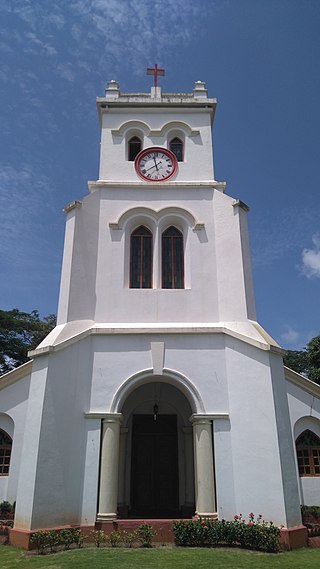
Mangalore, officially known as Mangaluru, is a major industrial port city in the Indian state of Karnataka and on the west coast of India. It is located between the Laccadive Sea and the Western Ghats about 352 km (219 mi) west of Bangalore, the state capital, 14 km north of Karnataka–Kerala border and 297 km south of Goa. Mangalore is the state's only city to have all four modes of transport—air, road, rail and sea. The population of the urban agglomeration was 619,664 according to the 2011 national census of India. It is known for being one of the locations of the Indian strategic petroleum reserves.
The Billava, Billoru, Biruveruor Bhillava people are an ethnic group of India. They are found traditionally in Tulu Nadu region and engaged in toddy tapping, cultivation and other activities. They have used both missionary education and Sri Narayana Guru's reform movement to upgrade themselves.

Mangalorean Catholics are an ethno-religious community of Latin Christians from the Diocese of Mangalore and the erstwhile South Canara area, by the southwestern coast of present-day Karnataka, India.
Jeppu is a locality in Mangalore city, Karnataka, India. It is situated on the southern part of Mangalore. Jeppu is on the bank of Nethravathi River. The National Highway 17 (India) passes through this locality.

The History of Mangalore dates back to the 3rd century BC and has been ruled by a number of rulers. In the era of modern India, the area was controlled by the Portuguese in Goa and Bombay, who lost it to Shivappa Nayaka, who in turn lost it to Hyder Ali.
Albuquerque tile factory is a tile factory at Hoige Bazaar, Bolar, Mangalore, Karnataka, India. It is the only tile factory whose tiles are recommended for Government buildings.
The culture of Mangalorean Catholics has been shaped by their Christianisation in Goa, their migrations& their captivity. They adopted elements of the local Mangalorean culture, but retained many of their Konkani customs and values. The ethnic Mangalorean houses of the older generation have spacious porticos, red oxide cemented floors, terra cotta roofs layered with the once famous Mangalore tiles. The houses are usually accompanied by their own private wells or ponds, and are normally attached to orchards of coconut trees, jackfruit trees, ice apple trees, Alphonso mango trees, areca nut trees etc.
The History of Mangalorean Catholics comprises three major eras. The first era consists of the cultural heritage shaped by Indo-Aryan migration into the Indus valley, later the migration to Govapuri and other prominent areas of the Konkan region, possibly due to a natural disaster that caused the drying up of the Sarasvati. Also, the various invasions and the political upheavals that followed in the pre-Partition eras of the northwest Indian subcontinent might be responsible for migration to Konkan in Western India. The second era was the legacy of Lusitanian culture, from the conversion of their Konkani ancestors to Roman Catholicism in the colonies of the Portuguese in Goa and Bombay, and the final era being the migration of the Roman Catholics in Goa to Mangalore and other parts of South Canara between the mid-16th and mid-18th centuries, forming a unique Mangalorean Catholic identity, and the subsequent growth and development of the community. Four centuries of living in South Canara gave these Catholics an identity of their own, distinct from Goans and Bombay East Indians.
Mangalorean Protestants are Protestants from South Canara and Coorg districts of the Indian state of Karnataka.
The architecture of Mangalorean Catholics has strong Mangalorean, Italian, and Portuguese influences.
Georg Plebst (1823-1888) was a German missionary who arrived India in 1851 and established one of the first tile making factories known as The Common Wealth Trust Ltd or locally addressed as Basel Mission tile factory in 1860, after they found large deposits of clay by the banks of the Gurupura and Nethravathi rivers. It was located near Morgan's Gate on the banks of the river Nethravathi. He left India in 1868.
The Common Wealth Trust Ltd or locally referred to as Basel Mission tile factory run by the German missionary Plebot, with an un-named Indian master-potter, was the first Mangalore tile manufacturing factory to be set up in India in 1860 on banks of the Nethravathi river near Morgan's Gate, about 10 kilometres (6.2 mi) from the Ullal bridge.
Morgan's Gate is a locality in Mangalore city of Karnataka state in India. It is situated around 4 km southeast to Hampankatta. It is known for the Basel Mission tile factory, founded in 1865. It is close to Mangaladevi Temple in Bolar. Mangalore Club, Mphasis and St. Rita's Church are the other landmarks in the area.
Alvares tile factory is a Mangalore tile factory in Mangalore. The tiles produced by this factory were in great demand throughout the Indian subcontinent and East Africa.
Participation of Mangalorean Catholics in the Indian Independence Movement recounts the community's role in the Indian Independence Movement.

Roof tiles are overlapping tiles designed mainly to keep out precipitation such as rain or snow, and are traditionally made from locally available materials such as clay or slate. Later tiles have been made from materials such as concrete, glass, and plastic.

Samuel Hebich (1803–1868) was one of the three pioneer Basel Mission missionaries to Southwestern India--Canara, Coorg, South Mahratta, Malabar, and Nilagiri. He, along with Johann Christoph Lehner and Christian Leonard Greiner commenced Basel Mission station, the first German mission station in India, at Mangalore.

Karnataka Southern Diocese is one of the twenty-two dioceses of the Church of South India covering the southern part of Karnataka. The other Church of South India dioceses in Karnataka are Karnataka Northern Diocese and Central Karnataka Diocese.

St. Paul's Church is an Anglican church in Mangalore, India.
Basel Mission Press is the first printing press of coastal Karnataka and was established in 1841 at Balmatta, Mangalore, India. This printing press was gifted to Gottfried Weigle by Basel Mission of Switzerland who had been to Bombay to get a booklet printed. Tulu Kirthanegalu by the lithographic process was the first book printed in the Manguluru Branch in 1941. In 1841, Gottfried Weigle obtained a printing press from Bombay and brought it back to Mangalore in 1842 with two Marathi printing assistants. In 1842, they published a Kannada pamphlet by Moegling and made 1500 copies. The next item was Christian Greiner's Tulu translation of St. Matthew's Gospel. In July 1843, the press began the first Kannada newspaper called "Mangalur-samachar" edited by Hermann Moegling. Two issues a month were produced until February 1844, after which it was printed in Bellary. Basel Mission Press celebrated its 175th anniversary celebrations in 2016. Basel Mission Press is now renamed as Balmatta Institute of Printing Technology and Book Craft offers courses in printing technology and book binding. The press is being maintained by Karnataka Christian Education Society (KACES) since 1972















